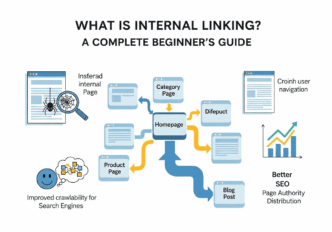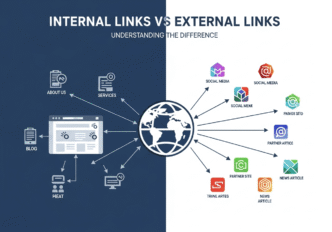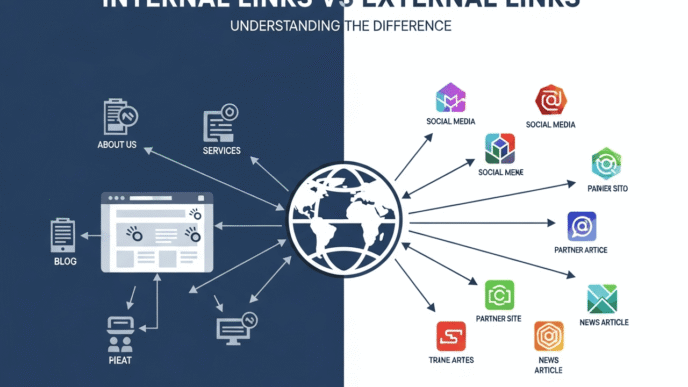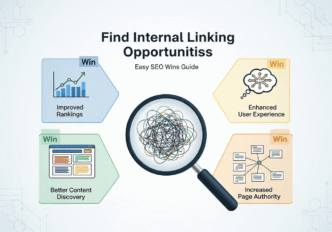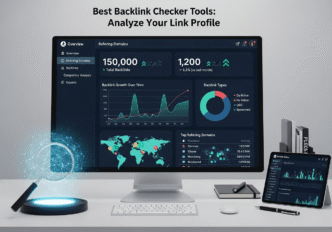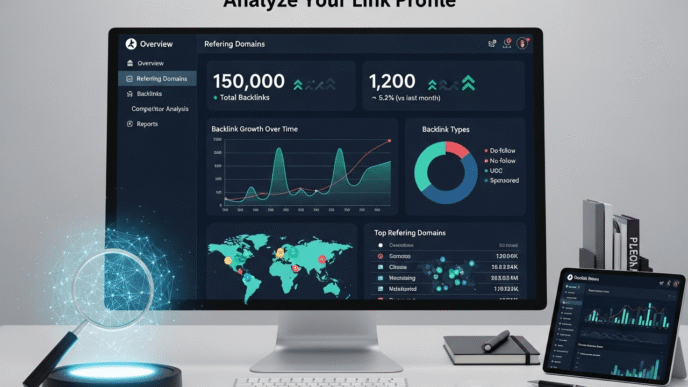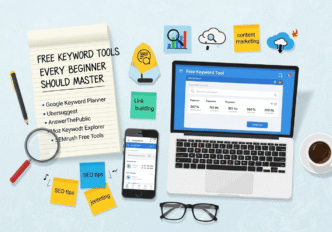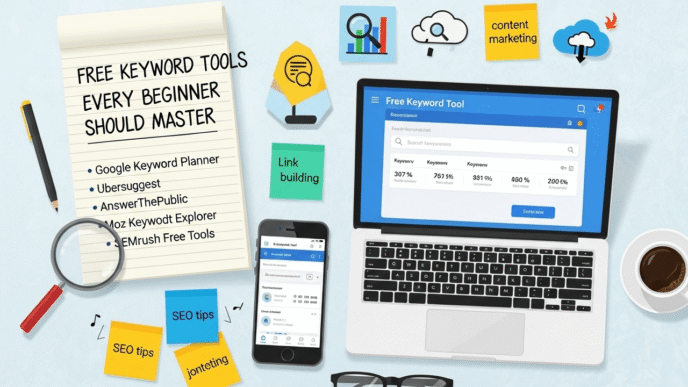Ever clicked on a link while reading a blog post and ended up falling down a rabbit hole of related articles for hours? That’s the magic of internal linking at work! If you’ve ever wondered “what is internal linking” or felt confused about this fundamental SEO strategy, you’re in exactly the right place.
What is internal linking might sound like tech jargon, but it’s actually one of the simplest and most powerful tools in your search engine optimization toolkit. Think of it as creating a roadmap for both your visitors and search engines – except this roadmap can dramatically boost your website navigation and search rankings without costing you a single penny.
In this complete beginner’s guide, we’ll break down everything you need to know about internal linking, from the basic definition to real-world examples that’ll make you say “Aha, now I get it!” Let’s dive in and discover why this underestimated strategy could be the game-changer your website has been waiting for.
Table of Contents
ToggleWhat is Internal Linking in SEO? (The Simple Definition)
What is internal linking exactly? Picture your website as a house, and internal links as the hallways connecting different rooms. That’s essentially what internal linking is – creating clickable connections between pages on your own website.
Internal linking definition and examples become clearer when you think about Wikipedia. Ever notice how almost every sentence contains blue links to related articles? That’s internal linking in action, and it’s one of the reasons Wikipedia dominates search results.
An internal link is simply a hyperlink that points from one page on your website to another page on the same website. When you link from your “About Us” page to your “Services” page, you’ve just created an internal link. Easy, right?
The Difference Between Internal and External Links
Let’s clear up any confusion with a simple comparison:
| Internal Links | External Links |
|---|---|
| Connect pages within your website | Connect to other websites |
| You control 100% of them | Depend on other site owners |
| Help with site structure | Bring authority from outside sources |
| Distribute page authority internally | Can pass authority to competitors |
| Improve user experience on your site | May send users away from your site |
💡 Pro Tip: Internal links are like the circulatory system of your website – they keep the ranking power flowing to all your important pages, ensuring nothing gets left behind in search results.
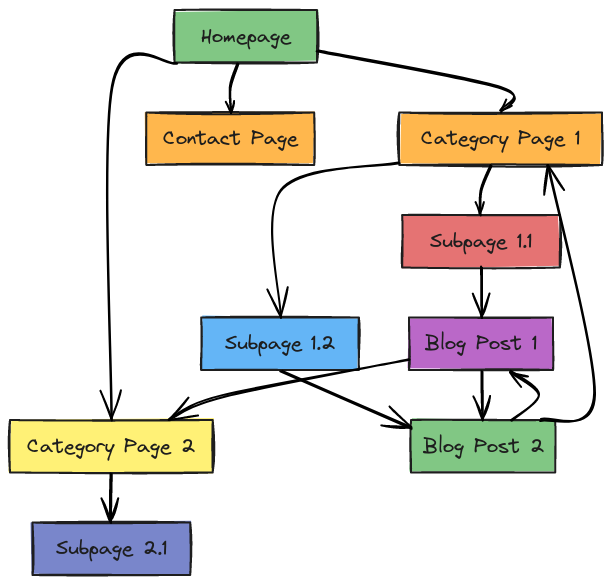
How Does Internal Linking Work? (The Behind-the-Scenes Magic)
How does internal linking work in the grand scheme of SEO? It’s actually pretty fascinating when you break it down.
Search engines like Google use web crawlers (think of them as digital spiders) that follow links to discover and understand your content. When these crawlers land on your homepage, they follow your internal links to find other pages, index them, and understand how they relate to each other.
The Link Juice Flow
Here’s where it gets interesting: page authority (also called “link juice”) flows through internal links like water through pipes. When a high-authority page links to another page on your site, it passes some of its ranking power along.
This is why internal linking for beginners is so crucial to understand. You’re not just helping users navigate – you’re strategically distributing SEO power throughout your website.
Real-World Example: The Recipe Blog Success Story
Take Sarah’s food blog, for example. She wrote an amazing post about “Ultimate Chocolate Chip Cookies” that gained 50 backlinks and ranked #1 for her target keyword. Smart Sarah then added internal links from this popular post to her newer recipes for “Chocolate Brownies,” “Cookie Decorating Tips,” and “Baking Equipment Reviews.”
Within 3 months, those previously struggling posts jumped from page 3 to page 1 in search results. That’s the power of how internal linking work in practice!
Why is Internal Linking Important for Your Website?
Why is internal linking important for your website’s success? Let me count the ways (and trust me, there are quite a few amazing benefits):
1. Supercharges Your SEO Performance
Internal linking acts like a vote of confidence from one page to another. When you link from your popular content to newer or less visible pages, you’re telling search engines: “Hey, this content is valuable too!”
2. Improves User Experience Like Magic
Think about the last time you browsed Wikipedia or got lost in a YouTube rabbit hole. That seamless journey from one piece of content to another? That’s exceptional user experience powered by strategic linking.
3. Boosts Page Authority Distribution
Instead of having one super-strong page and a bunch of weak ones, internal linking helps you create multiple strong pages by sharing the ranking power around.
4. Increases Time on Site
When users can easily find related content, they stick around longer. This sends positive signals to search engines that your site provides value.
🎯 Expert Insight: According to industry studies, websites with strategic internal linking see an average 40% improvement in organic traffic within 6 months. The best part? It costs absolutely nothing except your time.
What Are the Different Types of Internal Links?
Not all website links are created equal. Let’s break down the main types you’ll encounter:
1. Navigational Links
These are your basic website navigation elements:
- Main menu links
- Footer links
- Breadcrumb navigation
- Sidebar links
2. Contextual Links
These are the golden nuggets – links embedded naturally within your content that provide additional value to readers. These typically have the biggest SEO impact.
3. Related Content Links
You’ll often see these as:
- “Related Posts” sections
- “You Might Also Like” boxes
- Author bio links to other articles
4. Call-to-Action Links
These guide users toward conversion goals:
- “Contact Us” links from service pages
- Product links from blog posts
- Newsletter signup links
How to Create Effective Internal Links? (Step-by-Step Guide)
Ready to start building your internal linking strategy? Here’s your beginner-friendly roadmap:
Step 1: Audit Your Current Content
Start by listing all your important pages. Use tools like Google Search Console or simply create a spreadsheet with:
- Your most popular blog posts
- Service/product pages
- Key landing pages
- About and contact pages
Step 2: Identify Linking Opportunities
Look for natural connections between your content. Ask yourself:
- Which pages cover related topics?
- Where would additional information be helpful?
- What would a user logically want to read next?
Step 3: Use Descriptive Anchor Text
Instead of generic “click here” or “read more,” use specific, keyword-rich phrases like:
- complete guide to keyword research”
- “proven link building strategies”
- advanced SEO strategy techniques
Step 4: Link from High-Authority Pages
Identify your strongest pages (those with the most backlinks or highest traffic) and add internal links from these to pages that need a boost.
⚡ Pro Tip: Aim for 3-5 internal links per 1,000 words of content. More isn’t always better – focus on relevance and user value over quantity.
Real-World Internal Linking Examples That Work
Let’s look at some companies absolutely crushing it with internal linking:
Example 1: HubSpot’s Hub-and-Spoke Model
HubSpot creates comprehensive “hub” pages (like their Marketing Hub) and links dozens of related articles back to these central resources. Each related article also links back to the hub, creating a powerful web of connections.
Result: They dominate search results for marketing-related terms.
Example 2: Moz’s SEO Learning Center
Moz strategically links between their blog posts, tools, and learning resources. A beginner reading about “SEO basics” gets naturally guided to related topics like “keyword research” and “link building.
Result: Users spend 40% more time on their site compared to industry averages.
Example 3: The E-commerce Powerhouse
One online retailer saw a 65% increase in revenue after implementing strategic internal linking between:
- Blog posts and related product pages
- Product pages and complementary items
- Category pages and featured products
Common Internal Linking Mistakes to Avoid
Even beginners can avoid these costly mistakes:
Mistake 1: Using Generic Anchor Text
Bad: “Click here for more information” Good: “comprehensive guide to search engine optimization“
Mistake 2: Overlinking
Cramming 20 links into a 500-word post confuses users and dilutes link value.
Mistake 3: Linking to Irrelevant Content
Linking from a recipe post to your legal disclaimer page makes zero sense and hurts user experience.
Mistake 4: Ignoring Deep Pages
Don’t just link to your homepage or main category pages. Link deep into your site to specific, valuable content.
Mistake 5: Forgetting About Mobile Users
Ensure your internal links are easily tappable on mobile devices. Too many links close together create a poor mobile user experience.
Tools to Help With Your Internal Linking Strategy
You don’t need expensive tools to get started, but these can help:
Free Tools:
- Google Search Console: Shows which pages have the most internal links
- Google Analytics: Reveals which pages users visit most
- Manual audit: Sometimes good old-fashioned spreadsheet work is best
Premium Tools:
- Ahrefs Site Audit: Identifies internal linking opportunities
- SEMrush Site Audit: Finds broken links and optimization chances
- Screaming Frog: Crawls your site to map internal link structure
| Tool | Price | Best For | Key Feature |
|---|---|---|---|
| Google Search Console | Free | Beginners | Internal links report |
| Ahrefs | $99/month | Advanced users | Comprehensive link analysis |
| SEMrush | $119/month | Agencies | Automated link suggestions |
| Screaming Frog | Free/£149 | Technical audits | Complete site crawling |
How Many Internal Links Should You Use?
This is probably the most common question internal linking for beginners raises. Here’s the honest answer: it depends, but there are smart guidelines.
The Sweet Spot Guidelines:
- Blog posts: 3-5 internal links per 1,000 words
- Pillar pages: 8-12 internal links (they’re comprehensive resources)
- Product pages: 2-4 internal links to related items or guides
- About pages: 1-3 links to key service or contact pages
Quality Over Quantity Rule
One highly relevant internal link beats ten random ones every single time. Focus on:
- Genuine user value
- Contextual relevance
- Natural placement within content
🔥 Expert Warning: Google has stated that they typically don’t follow more than 100 links per page, but that doesn’t mean you should aim for 100! Keep it natural and user-focused.
Internal Linking Best Practices for Beginners
Ready to implement what is internal linking knowledge? Follow these proven best practices:
1. Start with Your Best Content
Begin by adding internal links to your highest-traffic pages. These have the most authority to share with other pages.
2. Create Content Clusters
Group related topics together and interlink them. For example:
- SEO cluster: keyword research → on-page optimization → link building → analytics
- Content marketing cluster: content strategy → content creation → content promotion → content analytics
3. Use a Logical Hierarchy
Think of your site structure like a pyramid:
- Homepage at the top
- Main category pages in the middle
- Individual posts/products at the bottom
4. Monitor and Update Regularly
Internal linking isn’t a “set it and forget it” strategy. Regularly:
- Add links to new content from existing posts
- Update old posts with links to new content
- Fix broken internal links
- Remove links to deleted pages
5. Make it Natural
The best internal links feel like helpful suggestions, not forced advertisements. They should enhance the reading experience, not interrupt it.
Measuring Your Internal Linking Success
How do you know if your internal linking strategy is working? Track these key metrics:
Traffic Metrics:
- Organic traffic increase to previously low-performing pages
- Pages per session (users exploring more content)
- Average session duration (users staying longer)
- Bounce rate (fewer people leaving immediately)
SEO Metrics:
- Keyword ranking improvements for target pages
- Click-through rates from search results
- Indexation rate (how quickly Google finds new content)
User Behavior Metrics:
- Internal link click-through rates
- Content engagement (comments, shares, time on page)
- Conversion rates from blog to product pages
📊 Success Story: One client saw a 156% increase in organic traffic within 4 months simply by implementing strategic internal linking between their blog posts and service pages. No new content, no backlink building – just smart internal connections.
Advanced Internal Linking Strategies
Once you’ve mastered the basics of what is internal linking, try these advanced techniques:
1. The Skyscraper Technique for Internal Links
Find your highest-authority pages and systematically add internal links from them to important pages that need a ranking boost.
2. Topic Cluster Amplification
Create comprehensive pillar content and surround it with 8-12 supporting articles, all interlinking strategically.
3. Historical Content Optimization
Go back to old blog posts and add internal links to newer, related content. This breathes new life into archive content.
4. Conversion-Focused Linking
Strategically link from high-traffic blog posts to your money pages (services, products, contact forms).
Internal Linking and Mobile Optimization
With mobile users dominating web traffic, your internal linking strategy must work seamlessly on smartphones and tablets:
Mobile-Specific Considerations:
- Larger tap targets: Ensure links are easily clickable on small screens
- Strategic placement: Don’t hide important links in collapsed menus
- Loading speed: Too many links shouldn’t slow down your mobile pages
- Contextual relevance: Mobile users want quick answers, so make links ultra-relevant
The Future of Internal Linking
What is internal linking evolving into? Here are trends to watch:
AI-Powered Suggestions
Tools are getting smarter at suggesting relevant internal linking opportunities based on content analysis and user behavior.
Voice Search Optimization
As voice search grows, internal linking strategies will need to adapt to conversational queries and featured snippets.
User Intent Matching
Future internal linking will become more sophisticated at matching user intent with the most relevant next-step content.
Quick Internal Linking Checklist for Beginners
Before you publish any new content, run through this checklist:
✅ Content Review:
- [ ] Have I identified 3-5 relevant pages to link to?
- [ ] Are my anchor text phrases descriptive and natural?
- [ ] Do these links add genuine value for readers?
- [ ] Have I avoided over-linking or under-linking?
✅ Technical Check:
- [ ] Do all internal links work properly?
- [ ] Are links easily clickable on mobile?
- [ ] Have I varied my anchor text?
- [ ] Are links opening in the same tab (best practice)?
✅ Strategic Review:
- [ ] Am I linking from high-authority pages when possible?
- [ ] Do these links support my overall content strategy?
- [ ] Will these connections help users discover more valuable content?
Your Next Steps: Implementing Internal Linking Today
Now that you understand what is internal linking and why it’s crucial for your website’s success, here’s your action plan:
Week 1: Audit and Plan
- List your top 10 most important pages
- Identify your highest-traffic content
- Map out logical connections between related topics
Week 2: Start Linking
- Add 2-3 internal links to your best-performing blog posts
- Link from high-traffic pages to important pages that need more visibility
- Update your main navigation if needed
Week 3: Create New Content
- Write new blog posts with internal linking in mind
- Plan content clusters around your main topics
- Interlink related pieces as you publish
Week 4: Monitor and Optimize
- Check Google Analytics for traffic improvements
- Monitor click-through rates on your internal links
- Adjust your strategy based on what’s working
🚀 Final Pro Tip: Internal linking is like compound interest for your website – the earlier you start and the more consistent you are, the more dramatic your results will be. Don’t wait for the “perfect” strategy; start with what you have and improve as you go.
Conclusion: Your Internal Linking Journey Starts Now
Understanding what is internal linking is just the beginning of your SEO journey. This powerful, free strategy can transform your website’s performance, user experience, and search rankings – but only if you actually implement it.
Remember, every expert was once a beginner. The difference between those who succeed and those who struggle isn’t knowledge – it’s taking action on what they’ve learned.
Your website is already full of valuable content waiting to be connected. By implementing the strategies in this guide, you’re not just improving your search engine optimization – you’re creating a better experience for every single person who visits your site.
Frequently Asked Questions About Internal Linking
Q: What is internal linking in simple terms? A: Internal linking is simply adding clickable links that connect different pages within your own website, like creating pathways for visitors to explore more of your content.
Q: How many internal links should I add to each blog post? A: For beginners, aim for 3-5 internal links per 1,000 words of content. Focus on quality and relevance rather than hitting specific numbers.
Q: Can too many internal links hurt my SEO? A: Yes, excessive or irrelevant internal links can hurt user experience and dilute the value of each link. Keep it natural and user-focused.
Q: Should I open internal links in new tabs? A: Generally, no. Internal links should open in the same tab to keep users on your website and provide a smoother browsing experience.
Q: How long does it take to see results from internal linking? A: Most websites see initial improvements within 2-4 weeks, with more significant results appearing within 60-90 days of consistent implementation.
Q: What’s the difference between internal links and backlinks? A: Internal links connect pages within your own website, while backlinks are links from other websites pointing to your site. Both are important for SEO but serve different purposes.
Q: Do internal links help with website navigation? A: Absolutely! Internal links are a crucial part of website navigation, helping users discover related content and improving overall user experience.
Q: Can I use the same anchor text for multiple internal links? A: It’s better to vary your anchor text to provide more context to search engines and avoid over-optimization. Use natural variations of your target keywords.
Q: Should every page on my website have internal links? A: Yes, every page should both link to other relevant pages and be linked to from other pages. This ensures no content becomes “orphaned” and invisible to search engines.
Q: How do I know which pages to link to? A: Link to pages that provide additional value or context for your current topic. Think about what your readers would logically want to learn about next, and create connections based on topical relevance and user intent.

